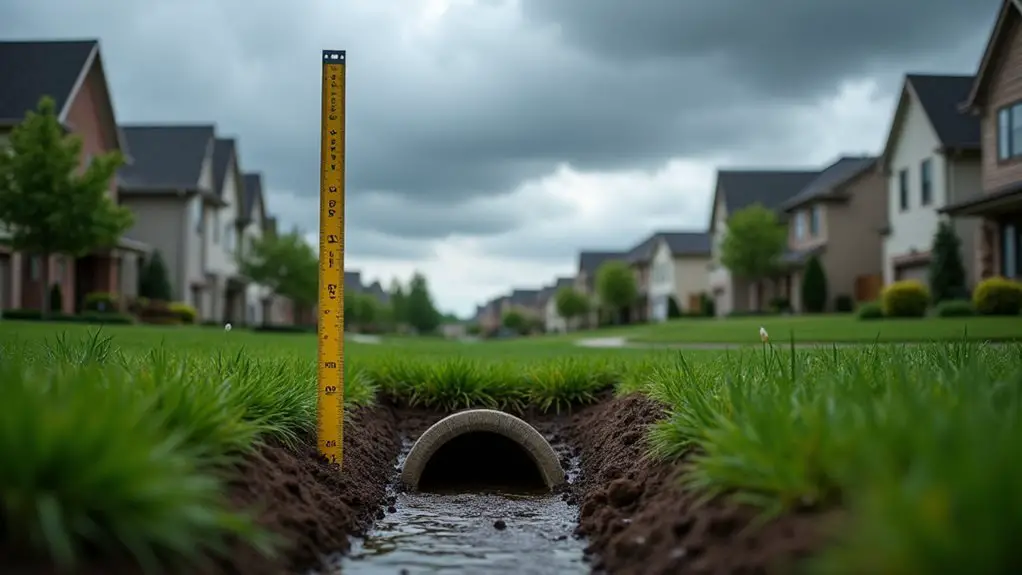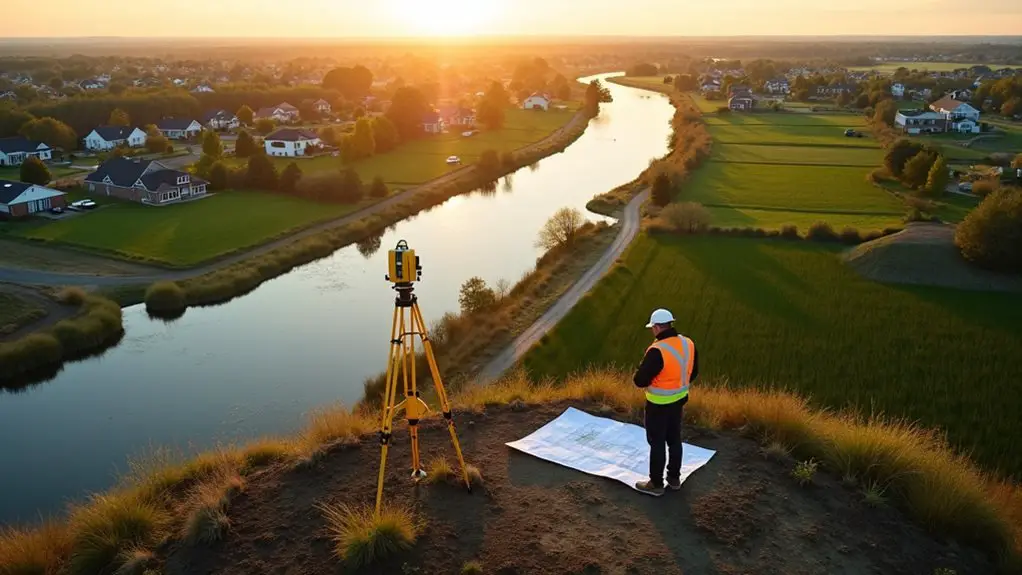A TA6 flood risk report is a specialized assessment you’ll need when your development project affects watercourses or sits within flood-prone areas under Transport Scotland’s jurisdiction. Unlike standard flood risk assessments, TA6 reports must comply with stringent DMRB technical standards and focus heavily on hydraulic modeling to analyze water flow patterns. They’re mandatory for projects in designated flood zones and require Transport Scotland’s approval rather than local authority sign-off. Understanding these requirements will help you maneuver through the complexities ahead.
Understanding the Purpose and Scope of TA6 Flood Risk Reports

When you’re dealing with flood-prone areas or planning new developments near water sources, a TA6 Flood Risk Report becomes an imperative document that can make or break your project’s approval.
This extensive evaluation examines potential flooding hazards and determines appropriate mitigation strategies for your specific site. The report’s primary purpose involves analyzing existing flood zones and evaluating how your proposed development might impact local water flow patterns.
You’ll need this documentation to satisfy planning authorities and demonstrate compliance with flood management regulations.
Beyond regulatory requirements, TA6 reports carry considerable insurance implications. Insurers rely on these evaluations to determine coverage options and premium rates for properties in flood-prone areas.
Without proper flood risk documentation, you might face higher costs or limited insurance availability, making the investment in a thorough TA6 report vital for long-term financial planning.
When TA6 Reports Are Required in the Planning Process
Planning authorities don’t require TA6 Flood Risk Reports for every development application, but specific circumstances will trigger this mandatory requirement.
You’ll need to submit a TA6 report when your proposed development sits within flood zones identified by the Environment Agency, particularly areas with high or medium flood risk.
The TA6 requirements overview shows that developments affecting watercourses, changing ground levels, or altering natural drainage patterns typically demand this assessment.
Planning implications become notable when your project involves constructing new buildings, extensions, or infrastructure in flood-prone areas.
Local planning authorities use these reports to evaluate whether your development poses risks to existing flood defenses or increases flood vulnerability elsewhere.
Understanding when you’ll need this report helps streamline your planning application and prevents costly delays in the approval process.
Key Components and Technical Elements of a TA6 Assessment

When you’re preparing a TA6 flood risk assessment, you’ll need to focus on three critical technical elements that form the backbone of your report.
Your hydraulic modeling requirements must demonstrate how water flows across and around your proposed development site, while your risk classification methodology will determine the specific flood risk category that applies to your project.
Finally, you’ll analyze potential mitigation measures that can reduce flood impacts, guaranteeing your development meets regulatory standards and protects both your investment and surrounding properties.
Hydraulic Modeling Requirements
Although flood risk assessments vary in complexity, hydraulic modeling forms the technical backbone of every TA6 report, requiring you to demonstrate how water behaves across your development site under different storm scenarios.
You’ll need to create detailed computer simulations that map water flow patterns, depths, and velocities during various flood events. These models must incorporate existing drainage infrastructure, proposed developments, and natural topography to guarantee accurate flood prediction.
Your hydraulic modeling should cover multiple return periods, typically ranging from 1-in-30-year to 1-in-1000-year events, including climate change allowances. The modeling software you choose must be industry-approved and capable of handling complex urban drainage systems.
Professional engineers typically use specialized programs that can simulate both surface water flooding and sewer network interactions for thorough analysis.
Risk Classification Methodology
Once you’ve completed your hydraulic modeling, you’ll need to systematically classify flood risks across your development site using established methodologies that translate complex water flow data into clear risk categories.
This classification process forms the backbone of your flood prediction analysis, determining whether areas qualify as low, medium, or high-risk zones.
Your risk assessment methodology typically follows national guidelines that consider factors like flood frequency, depth, velocity, and duration.
You’ll categorize areas based on annual exceedance probabilities, with 1% and 0.1% events serving as key thresholds.
The classification directly influences planning decisions, building requirements, and insurance considerations.
Each risk zone receives specific development constraints, guaranteeing your project complies with regulatory standards while protecting future occupants from potential flood hazards.
Mitigation Measures Analysis
Following your risk classification, you’ll develop extensive mitigation measures that directly address the specific flood hazards identified across your development site.
This analysis translates technical flood data into actionable flood prevention strategies, including sustainable drainage systems, flood barriers, and raised construction designs. You’ll examine how different mitigation options perform under various flood scenarios, considering both immediate protection and long-term effectiveness.
The analysis evaluates implementation costs, maintenance requirements, and potential environmental impacts of each proposed solution. Your consultant will prioritize measures based on risk severity and feasibility, creating a thorough protection framework.
This detailed assessment also addresses insurance implications, demonstrating to providers that you’ve implemented appropriate risk reduction measures, potentially reducing premium costs and improving coverage availability for your development project.
How TA6 Reports Differ From Other Flood Risk Assessments

You’ll find that TA6 reports stand apart from standard flood risk assessments through their specialized regulatory requirements and heightened technical standards.
While other flood studies might focus on broad risk identification, TA6 assessments demand precise hydraulic modeling, detailed consequence analysis, and thorough safety justifications that meet strict Environment Agency criteria.
The technical depth you’ll encounter in these reports reflects their critical role in protecting communities downstream from reservoirs, requiring evidence-based documentation that far exceeds typical flood risk evaluation protocols.
TA6 Specific Requirements
While standard flood risk assessments provide general guidance for development projects, TA6 reports operate under a specialized framework that demands considerably more rigorous analysis and documentation.
You’ll need to meet specific ta6 documentation requirements that go far beyond typical assessments, including detailed hydrological modeling, thorough site surveys, and extensive data collection protocols.
The ta6 report formats follow standardized templates with mandatory sections covering flood mechanisms, risk quantification, and mitigation strategies.
You must provide precise calculations, cross-reference multiple data sources, and include peer-reviewed methodologies.
Unlike general assessments, TA6 reports require independent verification and must demonstrate compliance with stringent technical standards.
Every conclusion needs supporting evidence, and you can’t rely on assumptions or simplified approaches that other flood assessments might accept.
Technical Detail Differences
The technical depth required in TA6 reports creates a stark contrast with conventional flood risk assessments that often rely on desktop studies and basic modeling approaches.
You’ll find that TA6 reports demand thorough hydraulic modeling, detailed topographical surveys, and extensive field investigations that other assessments typically skip.
While standard flood risk reports might reference existing flood mapping data, TA6 requires you to conduct original hydrological analysis and create bespoke flood models specific to your development site.
The assessment must also examine environmental impacts through detailed ecological surveys and habitat assessments, something basic flood reports rarely address.
This rigorous approach means you’re getting precise, site-specific flood risk data rather than generalized regional information that mightn’t accurately reflect your property’s unique circumstances.
Regulatory Compliance Standards
Beyond the technical complexities lies another fundamental distinction: TA6 reports operate under a completely different regulatory framework than standard flood risk assessments.
While conventional flood studies follow general planning guidelines, TA6 reports must meet specific Transport Scotland standards and comply with DMRB requirements. You’ll encounter unique compliance challenges when maneuvering through these specialized regulatory frameworks, as they demand adherence to stringent technical specifications that don’t apply to typical assessments.
The approval process also differs markedly.
Standard flood risk assessments typically require local authority sign-off, but TA6 reports need Transport Scotland’s validation. This creates additional layers of scrutiny and documentation requirements. You must demonstrate compliance with trunk road infrastructure standards, which involves more rigorous peer review processes and detailed technical justifications that aren’t necessary for conventional flood studies.
The Process of Commissioning and Preparing a TA6 Report

When you’re facing potential flood risks for your development project, commissioning a TA6 report becomes a critical step that requires careful planning and coordination.
The commissioning process begins with selecting a qualified flood risk specialist who understands local drainage systems and regulatory requirements. You’ll need to provide detailed site plans, proposed development layouts, and any existing drainage information to facilitate thorough report preparation.
Your chosen consultant will conduct site surveys, analyze local watercourses, and assess potential flood pathways. They’ll evaluate your development’s impact on existing drainage systems and propose mitigation measures.
The report preparation typically takes 2-4 weeks, depending on site complexity and data availability. You’ll receive an extensive document detailing flood risks, proposed solutions, and recommendations for sustainable drainage systems that satisfy planning authorities’ requirements.
Cost Considerations and Timeline Expectations for TA6 Reports
Understanding the financial investment required for your TA6 report helps you budget effectively for this regulatory requirement.
The cost breakdown typically ranges from £1,500 to £5,000, depending on your project’s complexity and site-specific factors. Simple residential developments often fall on the lower end, while commercial projects with intricate drainage systems command higher fees.
Timeline management becomes essential when coordinating with planning applications. Most consultants complete TA6 reports within 2-4 weeks after receiving your site information and project details.
However, you’ll need additional time if they require supplementary surveys or encounter complications during the assessment process.
Planning ahead prevents delays in your development timeline. Contact qualified flood risk consultants early, providing detailed project information to guarantee accurate quotes and realistic completion schedules for your specific requirements.
Final Thoughts
Picture yourself standing at the crossroads of development and flood safety, where your TA6 report becomes the critical bridge between ambitious plans and environmental reality. You’ve traversed the technical requirements, understood the costs, and grasped the timeline—now you’re equipped to move forward confidently. This thorough assessment isn’t just paperwork; it’s your project’s lifeline, guaranteeing you’ll build safely while meeting regulatory demands and protecting surrounding communities.
- What Is a TA6 Flood Risk Report? - August 21, 2025
- Why UK Landlords Are Abandoning Personal Ownership for Limited Companies in Droves - August 5, 2025
- Why London May Not Be the Ultimate UK Residential Investment Hotspot Anymore - August 5, 2025


